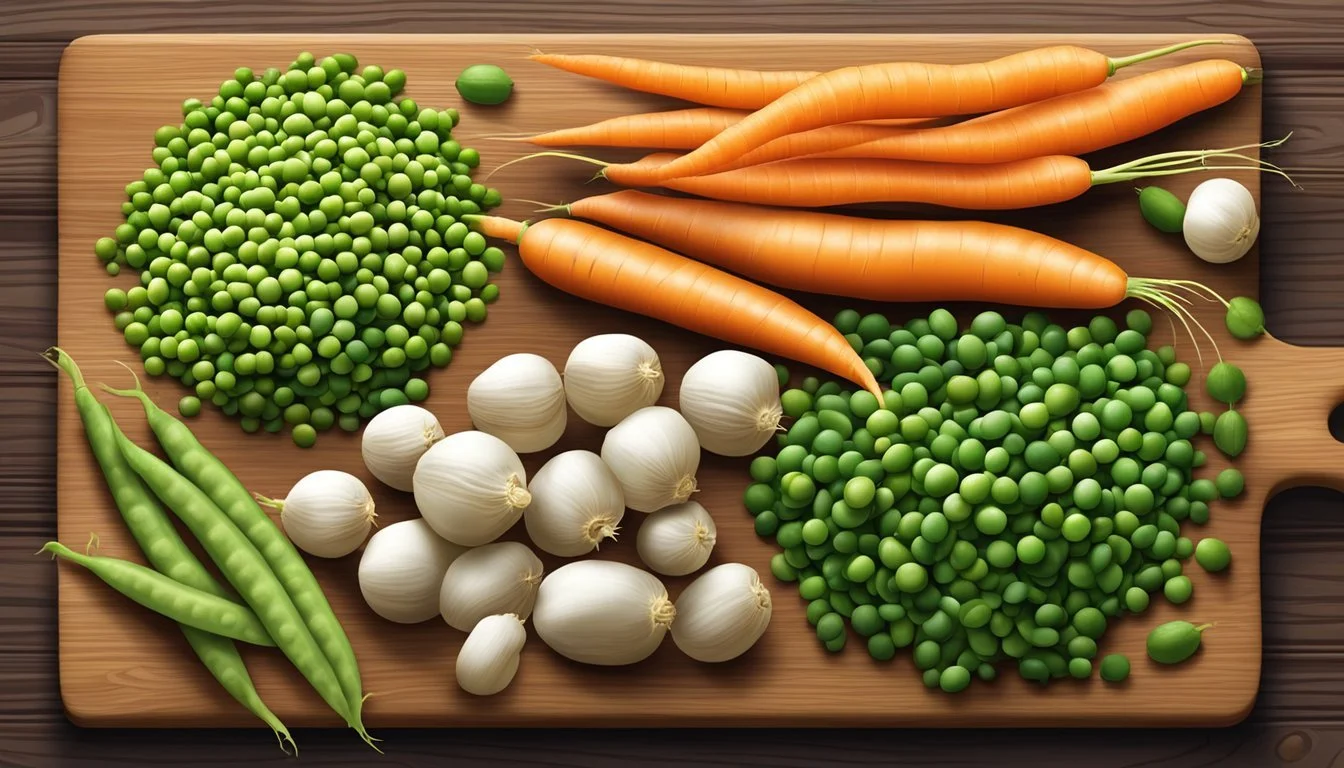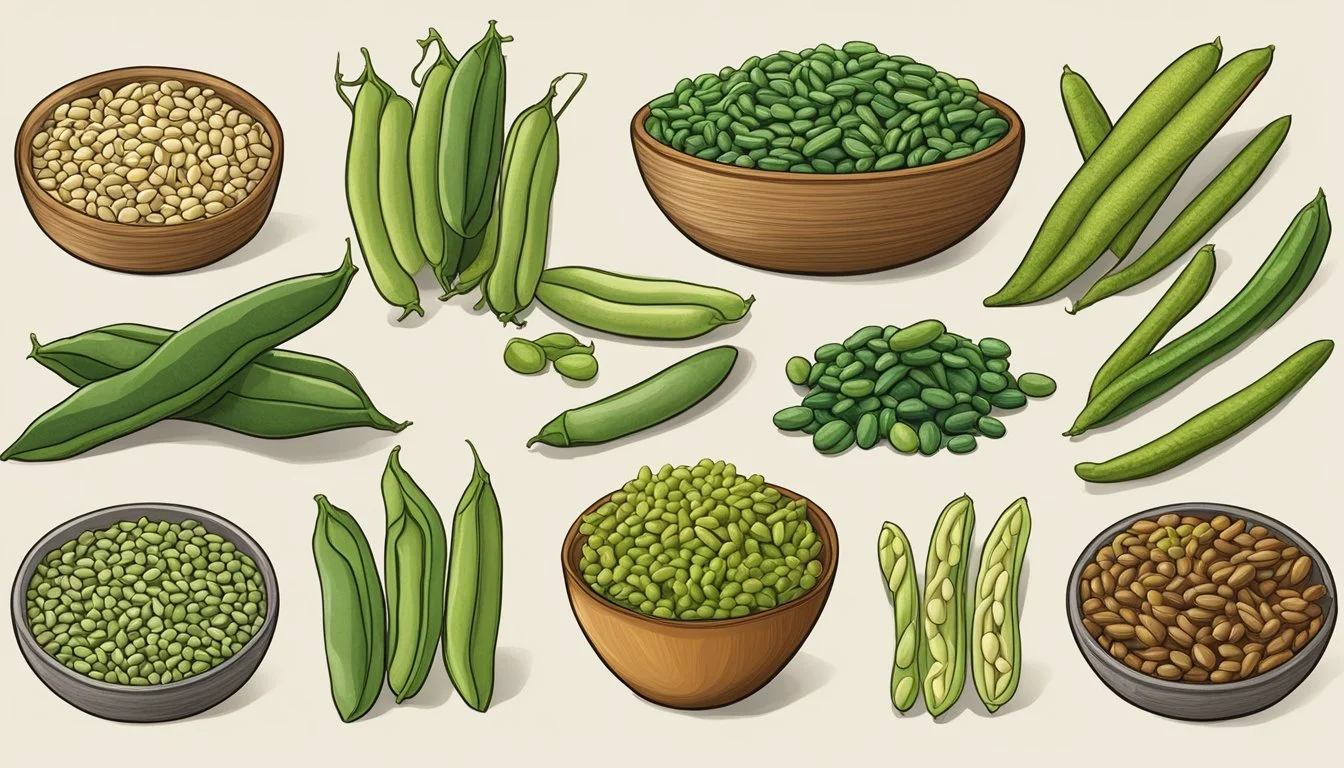Cluster Beans Substitutes
Top Alternatives for Cooking
Finding substitutes for cluster beans is essential when they aren't available at your local market or when you want to experiment with different flavors and textures in your recipes. Cluster beans, also known as guar beans, are rich in fiber and low in calories, making them a nutritious addition to any meal.
When you can't find cluster beans, consider using green beans, snow peas, or even French beans as they offer similar textures and nutritional benefits. These alternatives can be easily incorporated into a variety of dishes without compromising on taste or health benefits. Each of these legumes brings its unique qualities to the table, ensuring that your recipes remain delicious and nutritious.
Understanding the best substitutes for cluster beans allows for greater culinary flexibility and ensures that your meals are both diverse and satisfying.
Nutritional Profile of Cluster Beans
Cluster beans, also known as guar beans, are a nutritious vegetable packed with various essential nutrients. They are particularly notable for their protein, fiber, vitamins, and minerals, all of which play vital roles in supporting overall health.
Protein and Fiber Content
Cluster beans are a good source of plant-based protein, essential for muscle repair and growth. They contain approximately 3 grams of protein per cup (raw). This makes them a valuable addition to vegetarian and vegan diets.
In terms of fiber, cluster beans shine with about 5 grams per cup. Dietary fiber aids in digestion and helps prevent constipation. It also contributes to heart health by reducing cholesterol levels and regulating blood sugar levels, making cluster beans beneficial for those managing diabetes.
Vitamins and Minerals
Iron: Cluster beans are rich in iron, with about 22% of the daily recommended intake per 100 grams. Iron is crucial for maintaining healthy blood and preventing anemia.
Calcium: With 12% of the daily value, calcium in cluster beans supports bone health and proper functioning of the heart, muscles, and nerves.
Potassium: Essential for heart health and muscle function, cluster beans provide a significant amount of potassium, contributing to balanced electrolytes and blood pressure regulation.
Vitamins: They are particularly high in vitamin A (4%) and C (3%), which are antioxidants that support vision, immune function, and skin health.
Calories and Carbohydrates
Cluster beans are low in calories, making them suitable for weight management. One cup of raw cluster beans contains roughly 30 calories. This low-calorie count, combined with high fiber content, helps in maintaining satiety without excessive calorie intake.
In terms of carbohydrates, cluster beans are relatively low, with 5-6 grams per cup. The carbohydrates in these beans are complex, providing sustained energy without rapid blood sugar spikes. This makes them particularly beneficial for people looking to manage their carbohydrate intake.
Cluster beans stand out as a nutrient-dense vegetable, rich in protein, fiber, vitamins, and minerals, making them a valuable addition to any diet.
Health Benefits of Cluster Beans
Cluster beans, also known as guar, are packed with nutrients that contribute to a variety of health benefits. Rich in dietary fiber, protein, vitamins, and minerals, they support digestive health, help regulate blood sugar levels, and aid in weight management.
Digestive Health
Cluster beans are an excellent source of dietary fiber, which plays a crucial role in promoting digestion and preventing constipation. The fiber content improves gut health by fostering a healthy environment for beneficial bacteria. Additionally, the high soluble fiber content can help lower cholesterol levels, which benefits heart health.
Eating cluster beans regularly aids in smoother bowel movements. They can help reduce instances of bloating and digestive discomfort, particularly if consumed in moderate amounts and cooked properly.
Blood Sugar Regulation
Cluster beans can help maintain stable blood sugar levels, a vital factor for individuals managing diabetes. The presence of soluble fiber in cluster beans slows down the absorption of sugar in the bloodstream. This can help prevent spikes in blood sugar levels after meals.
Including these beans in a diabetic-friendly diet ensures a steady release of energy, making them a smart choice for blood sugar management. Cluster beans also contain certain proteins that may contribute to better insulin response.
Weight Management
Low in calories but high in fiber, cluster beans support weight loss by promoting a feeling of fullness, which can reduce overall calorie intake. They are a nutrient-dense food, providing essential vitamins and minerals without adding excessive calories.
The protein and fiber combination aids in muscle repair and growth while also maintaining energy levels. As a result, incorporating cluster beans into meals can help in managing weight effectively without compromising on essential nutrients.
Cluster beans are both nutritious and versatile, making them an excellent addition to a balanced diet for better digestive health, blood sugar regulation, and weight management.
Common Cluster Beans Substitutes
When cluster beans are unavailable, several alternatives can be used to achieve similar nutritional benefits and culinary effects. These substitutes range from various types of beans and legumes to other vegetables and protein sources.
Beans and Legumes Alternatives
Kidney beans, navy beans, and pinto beans are excellent substitutes for cluster beans due to their rich protein content. Great northern beans and cannellini beans offer a mild flavor and a creamy texture that can complement many dishes. Chickpeas and black beans provide both protein and fiber, making them nutritious alternatives.
Lentils, especially green and brown varieties, can substitute for cluster beans in stews and soups. They cook quickly and have a moderately similar texture, making them versatile in various recipes. Lima beans also serve well in dishes requiring a tender bite.
Vegetable Substitutes
For those seeking vegetable options, green beans and French beans are practical alternatives. Their similar structure and crunch make them suitable for salads, stir-fries, and casseroles. They can be steamed or sautéed with spices to mimic the flavor profile of cluster beans.
Snow peas and sugar snap peas offer a sweet flavor and crisp texture, useful in fresh salads and light sautés. Zucchini and bell peppers can also replace cluster beans in cooked dishes, providing color and a mild taste.
Other Protein Sources
Tofu stands out as a flexible substitute, especially in vegan and vegetarian diets, due to its ability to absorb flavors from spices and sauces. When cooked, tofu can mimic the texture of cluster beans in stir-fries and curries.
Edamame, young soybeans, offer a similar crunch and are rich in protein. They can be boiled and added to salads or used in place of cluster beans in mixed vegetable dishes.
Mushrooms, particularly shiitake and button varieties, though not a direct replacement, can provide a savory, umami flavor. This makes them suitable for adding depth to stews and soups.
Using Substitutes in Different Dishes
When replacing cluster beans in recipes, choosing the right substitutes can maintain or even enhance the dish's flavor and texture. Consider how the substitute will interact with other ingredients and their cooking times.
Soups and Salads
In soups, broad beans or green beans can seamlessly replace cluster beans. They maintain texture and absorb flavors well. For salads, chickpeas and kidney beans are excellent choices, providing a creamy texture and hearty profile.
Green beans are versatile and their fresh, slightly sweet flavor matches well with dressings in cold salads. Chickpeas add a nutty flavor that complements a variety of salad dressings and toppings such as chopped vegetables, herbs, and nuts.
Main Courses and Side Dishes
Eggplant works well in place of cluster beans in curries and hot dishes. Its ability to soak up flavors and become tender when cooked makes it ideal for dishes like sabzi and stews. Zucchini, as a less robust but suitable alternative, can be used in mixed vegetable stir-fries and gratins.
Soybeans make a great substitute in bean-based curries. They're higher in protein and can carry spices effectively in dishes served with rice or pasta. Incorporating more grains like quinoa into main dishes can also provide a good texture mix and nutritional balance.
Snacks and Appetizers
For hummus and dips, edamame beans are an exciting alternative. They add a lighter, fresher taste while maintaining a creamy consistency.
When making appetizers like stuffed vegetables, consider using black beans. They offer a meaty texture and pair well with spices and ingredients typically used in snack recipes.
For a healthy, crunchy snack, roasted chickpeas can replace cluster beans. They can be tossed with chili powder for extra heat or seasoned with herbs for a more subtle flavor.
By carefully selecting substitutes, it is possible to create diverse and flavorful dishes without the need for cluster beans.
Culinary Techniques for Substitutes
When substituting cluster beans, it is essential to understand the proper cooking methods, seasoning alternatives, and texture creation techniques to ensure the final dish remains flavorful and satisfying.
Cooking Methods for Beans and Legumes
Cooking substitutes like beans and legumes often starts with soaking to reduce cooking time and enhance texture. Dry beans, including black beans and kidney beans, should be soaked overnight and then boiled until tender, usually for about an hour. Canned beans require thorough rinsing to remove preservative salts and are ideal for quick preparations.
Using a slow cooker or pressure cooker can achieve a creamy texture with minimal effort. For example, chickpeas cooked in a pressure cooker develop a smooth, almost buttery texture that can rival traditional cluster beans.
Seasoning and Flavoring Alternatives
Proper seasoning is key in replacing the somewhat mild flavor of cluster beans. Salt, garlic, cumin, and pepper are staple seasonings that can be used to enhance the flavor. Onion and ginger also add depth and complexity. For a Middle Eastern twist, adding tahini and lemon provides a refreshing zest.
Spices like cumin and coriander seeds can be toasted to release their oils and ground for a more robust flavor. Pepper and paprika can introduce heat and smokiness, elevating simple substitutes like green beans or snow peas.
Creating Texture in Substitutes
Achieving the right texture is crucial, especially when replacing the unique crunchiness of cluster beans. Blanching alternatives like broccoli stems or asparagus can retain their crunch if not overcooked. For a creamy texture, blending white beans or refried beans with a bit of olive oil mimics the mouthfeel of well-cooked cluster beans in purees or spreads.
Cooking methods like roasting can create crispy edges while retaining a tender inside. Sautéing with garlic and onions in a bit of oil helps maintain a pleasing texture. Additionally, steamed vegetables like green beans achieve a soft yet firm bite.
Cultural Considerations for Substitutes
When using substitutes for cluster beans, it's essential to consider the cultural traditions and culinary expectations associated with Indian cuisine. Understanding these elements helps in selecting appropriate substitutes that harmonize with traditional dishes.
Cluster Beans in Indian Cuisine
Cluster beans, also known as guar or Cyamopsis tetragonoloba, hold significant cultural and culinary importance in India. They are often employed in various sabzi (vegetable dishes) and curries. These beans are cooked with spices like cumin and turmeric, creating flavors that are integral to Indian cuisine.
Including navy beans as a substitute could be a practical option, but it's critical to adapt their preparation method to Indian cooking styles. For instance, adding sautéed onions, turmeric, and coriander leaves can help mimic the authentic taste of cluster beans dishes.
Adapting Substitutes to Regional Dishes
To adapt substitutes like navy beans or other beans to regional dishes, it's important to replicate the texture and flavor profile of cluster beans. The use of spices such as cumin and coriander seeds can bring the substitute closer to the traditional taste. Including ingredients like tahini might also work in recreating the rich, creamy sauces found in some Indian curries.
Carefully incorporating these substitutes into traditional recipes while retaining the essence of the original dish ensures that cultural integrity is maintained. By respecting the traditional method of preparing and seasoning dishes, one can seamlessly introduce alternative ingredients without compromising on flavor or cultural significance.







